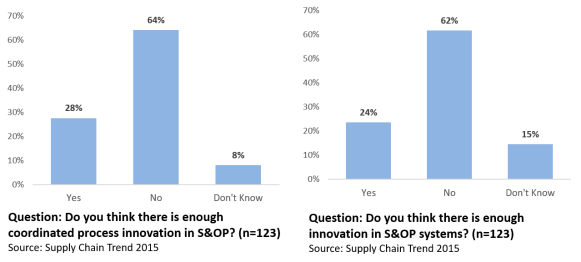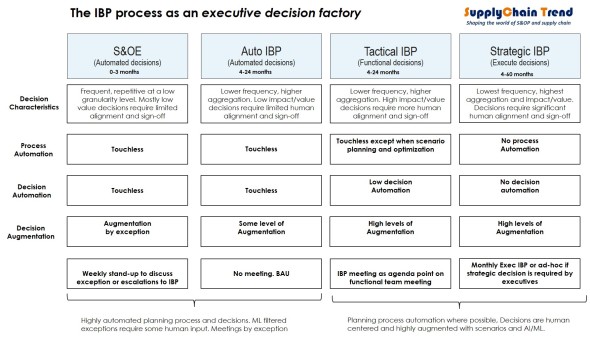When I was IBP manager at a multi-billion-dollar CPG company about 10 years ago, I remember a marketing director telling me just before the executive IBP meeting; ‘Niels, this feels like going to the dentist every month’.
I agreed with him. Back then, preparing for a monthly IBP meeting was a painful, tedious effort, with my full planning team consumed and running overtime to get the IBP decks out in time. An environment with multiple ERP and APS systems to gather our data did not help. A visit to the dentist was probably more fun indeed!
Once we were in the meeting, the marketing director as P&L owner and I would be happy to be able to get through the KPI dashboard, the NPD pipeline and a feasible volume and value projection of the categories we were responsible for. It was a lot of FYI. If we were lucky some decisions were being made, but none were executive paygrade decisions really.
Since then a lot has changed…and a lot has not!
What has not changed for Integrated Business Planning
What unfortunately has not changed, is that preparing an IBP deck is often still a tedious piece of work. Companies now have even more ERP, APS, data lakes and other systems to gather IBP data from. For some global companies we talk about dozens! A recent study suggests that supply chain planners spend 50% of their time on data gathering and tinkering with it. Knowing this, who wants a job in supply chain planning when you just finished your degree? How can supply chain attract the best talent when all you do is tying data together?
A lack of IBP process and system innovation was definitely the feedback I got in my 2015 and 2017 S&OP Pulse Check, where 64% of respondents thought there wasn’t enough IBP process innovation and 62% thought there wasn’t enough system innovation.
Although some new ideas are popping up lately, the IBP process itself has indeed not really evolved all that much in the last ten years. I still see a lot of that same IBP process slide that has been around for 30 years. Because of a lack of process innovation, partially driven by overzealous IBP process compliance, IBP remains more of a process factory rather than an executive decision factory.
What has changed for Integrated Business Planning
Although the feedback by IBP practitioners was a lack of system innovation to support them, a lot has changed since then. Back then, Big Data was still a hype with not too many relevant business cases. Now machine learning algorithms are integrated in many planning systems and happily chew away at Big Data to come up with planning improvement suggestions. We see examples of digital planning twins, where the underlying planning process is fully digitised, so it can be autonomous or ‘no-touch’. Cognitive automation has become a reality, supporting planners with complex planning decision making at scale and speed. This can now be done across the dozens of ERP and APS systems as smart data crawlers can create one common IBP data layer across the whole enterprise, accessible at real-time in the cloud. Those same data crawlers can write back information and decisions, making a planning process self-driving where this is valuable to do so.
What has changed recently, is that COVID19 has woken the world up to global supply chain dependencies, increased demand and supply disruption and a need for both supply chain resilience and strategic agility. Keeping a supply chain and company strategy intact and relevant in this environment is the main challenge in this new normal. IBP ought to deploy a company’s strategy, however the old, tedious monthly process will not suffice anymore to support this goal in our fast-changing world.
How to align the IBP process with technology
What we’ve witnessed the last 10 years is asymmetric innovation in IBP processes and supporting systems. Whilst new planning systems are shooting for the stars, making things possible I could only dream of before that IBP meeting 10 years ago, the process has not evolved with it. As proponents and drivers of the IBP process, trying to take the rest of the business in our IBP-slipstream, supply chain professionals and consultants only can blame themselves for this.
For decades the IBP process was leading, now technology is leading. How can the IBP process catch-up?
To make IBP an executive decision-making process it ought to be, answering complex questions at the speed of a business in the 21st century, supported by finite planning resources, my suggestion is to segment the IBP process in four elements as per below diagram. As we want to make IBP a decision making factory, the segments are based on decisions characteristics.
Sales & Operations Execution (S&OE): Frequent, repetitive at a low granularity level. Mostly low value decisions require limited alignment and sign-off. Both planning process and decisions in this horizon can be automated. Machine learning driven exceptions requires human intervention, supported by a quick weekly or ad-hoc stand-up.
Auto IBP: Lower frequency, higher aggregation. Low impact/value decisions require limited human alignment and sign-off. Both planning process and decisions in this horizon can be automated. Some planning augmentation might be needed when the auto IBP mode requires a step back and needs some human intervention. No meeting is needed for low frequency low value decisions.
Tactical IBP: Lower frequency, higher aggregation. High impact/value decisions require more human alignment and sign-off. Scenario planning and optimization play a large role here and therefore requires high levels of decision augmentation. Decisions have a cross functional impact, however, are not strategic by nature and can be made in a functional team meeting setting.
Strategic IBP: Lowest frequency, highest aggregation and impact/value. Decisions require significant human alignment and sign-off. These high value or strategic decisions are executive pay grade level. Planning process and decisions can’t be automated, but they require decision augmentation to develop recommendations to executives. Decisions can be made in a periodic executive meeting, or ad-hoc if quick decisions are required quickly.
Conclusion
The IBP process as an executive decision factory will use technology to automate planning processes and decision making in the Auto IBP and Tactical IBP segments. Technology will further augment planners with decisions making where required in Tactical and Strategic IBP. In Strategic IBP, decision augmentation and human centricity in decisions are leading. Relevant IBP data will be available for supply chain planners, who will be able to focus on bigger problems and preparing executive decisions, rather than wasting their time and intelligence on gathering data or on the less impactful Auto IBP.
The Strategic IBP meeting will become the ‘new’ executive IBP meeting, aiming to keep strategy intact and agile. It will use ad-hoc meetings when recommendations are available to solve some of the bigger problems. It won’t require all the time and baggage of the Auto IBP and Tactical IBP, which can be solved functionally, by non-executives or by the machine. When this IBP segmentation happens, for the first time since its inception, IBP might be called a real executive process.
P.S. I look forward to you joining the conversation in the comments and take this discussion forward.
Cheers, Niels
Photo credit: oilandgasaustralia




Niels, a very worth framework. Is essentially how we have setup most of our clients. Even patenting a real time S&OP technology we call Order Commitment in 2010.
What has setup back this approach however is the availability of synchronized supply chain data from the extended enterprise. I our experience the process is not possible without the data ! The silo’ed IT frameworks of most companies that evolved out of an over reliance on an ERP technology framework have made this constraint far worse
So breaking open the decentralized access to the feed data of S&OP is what we believe can be the differance maker. When and how this data is used with the basic S&OP algorithms become much simpler if there is reliable supply chain execution synchronized foundational feeds to the supply and demand netting !
Cheers
Jon